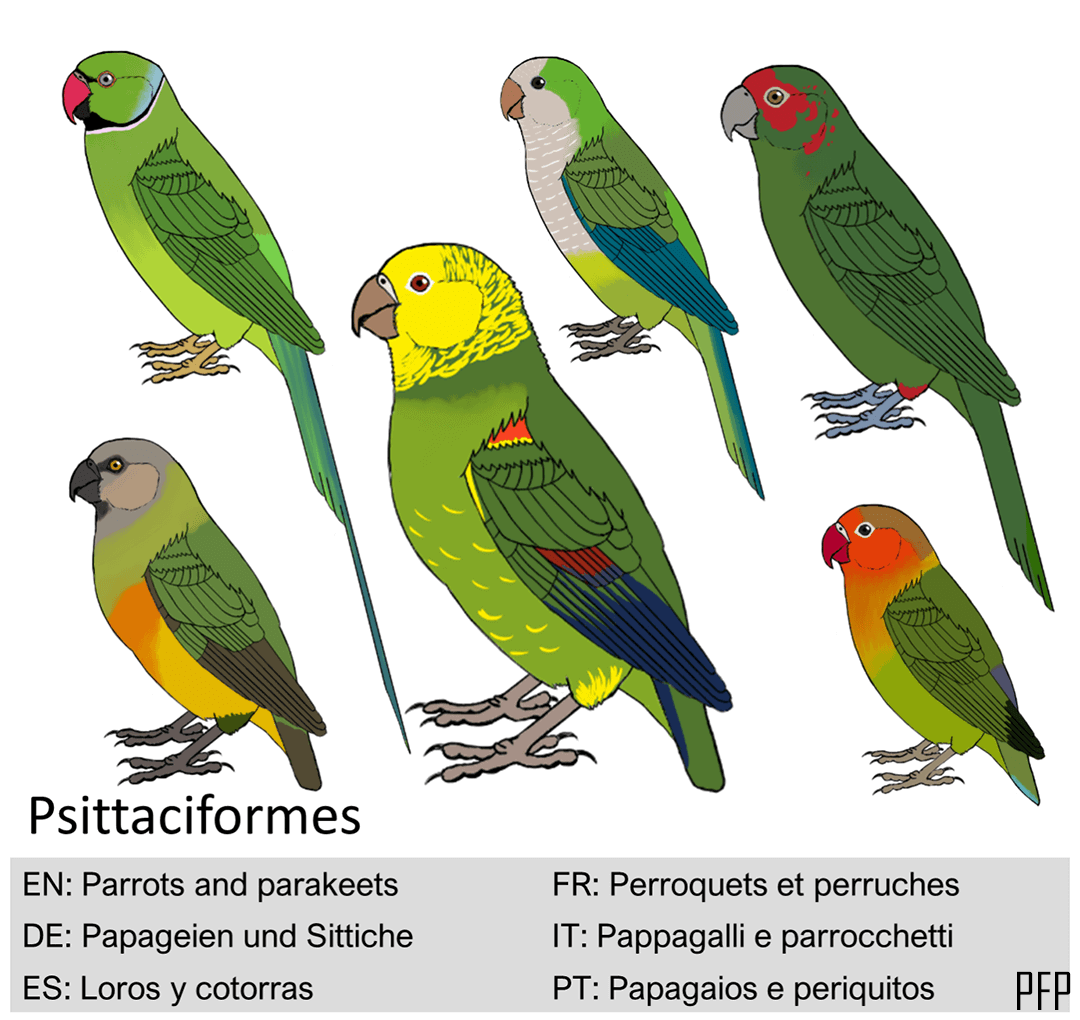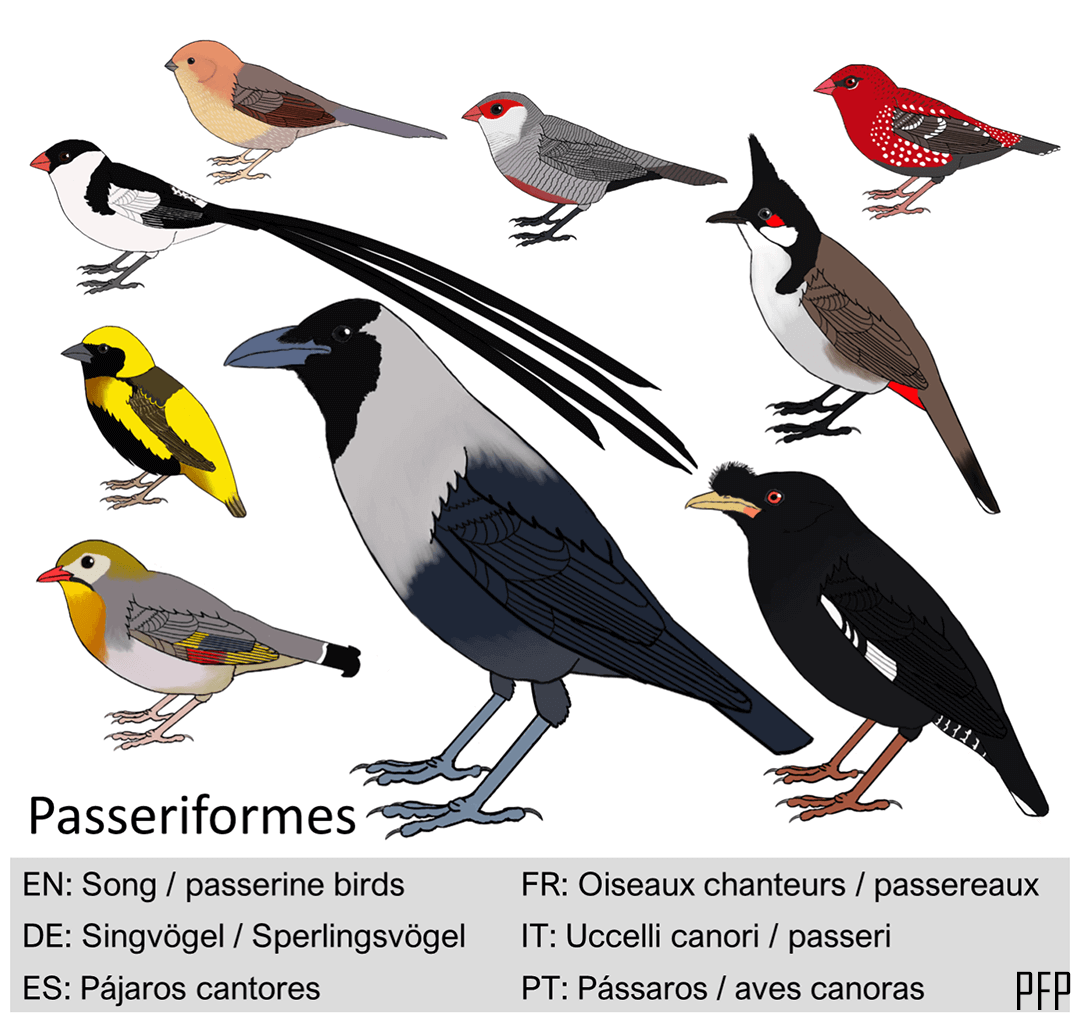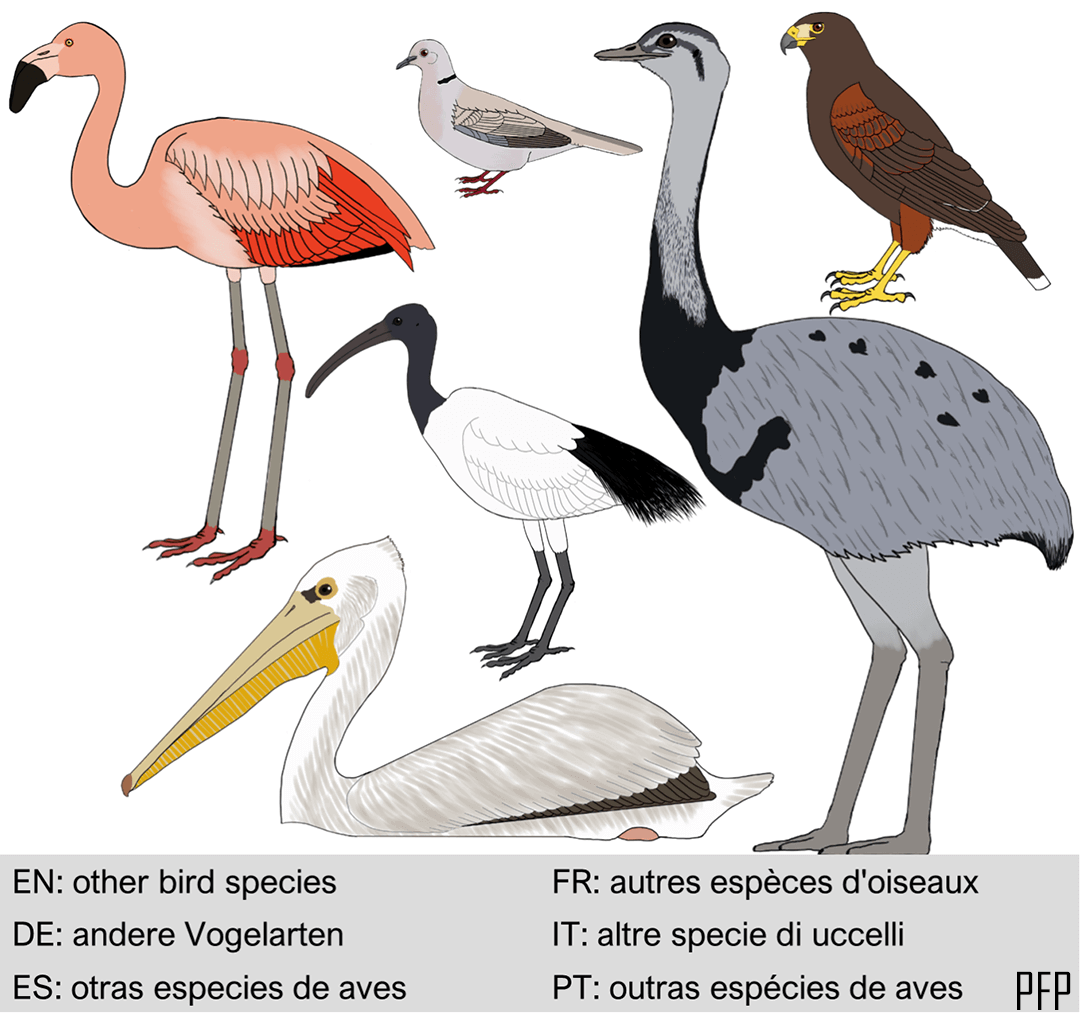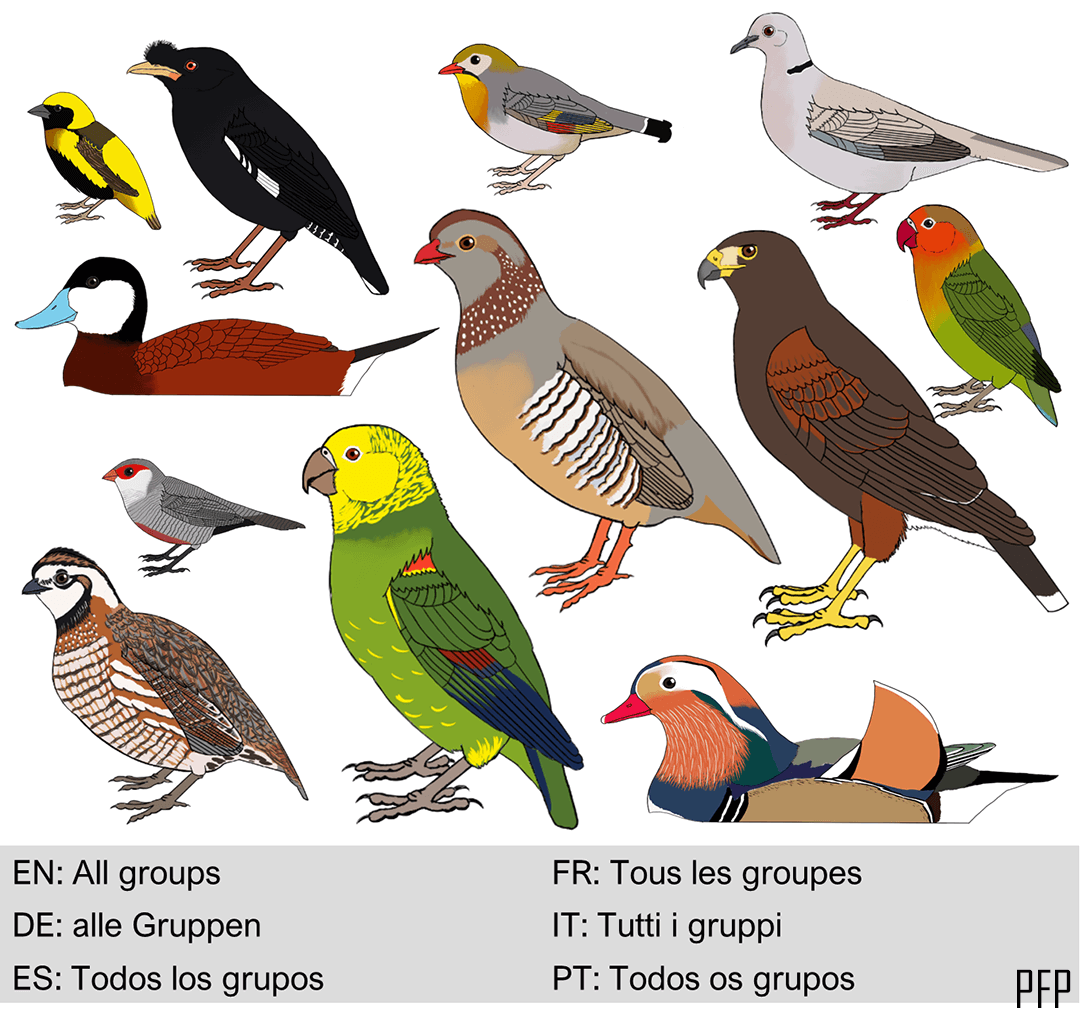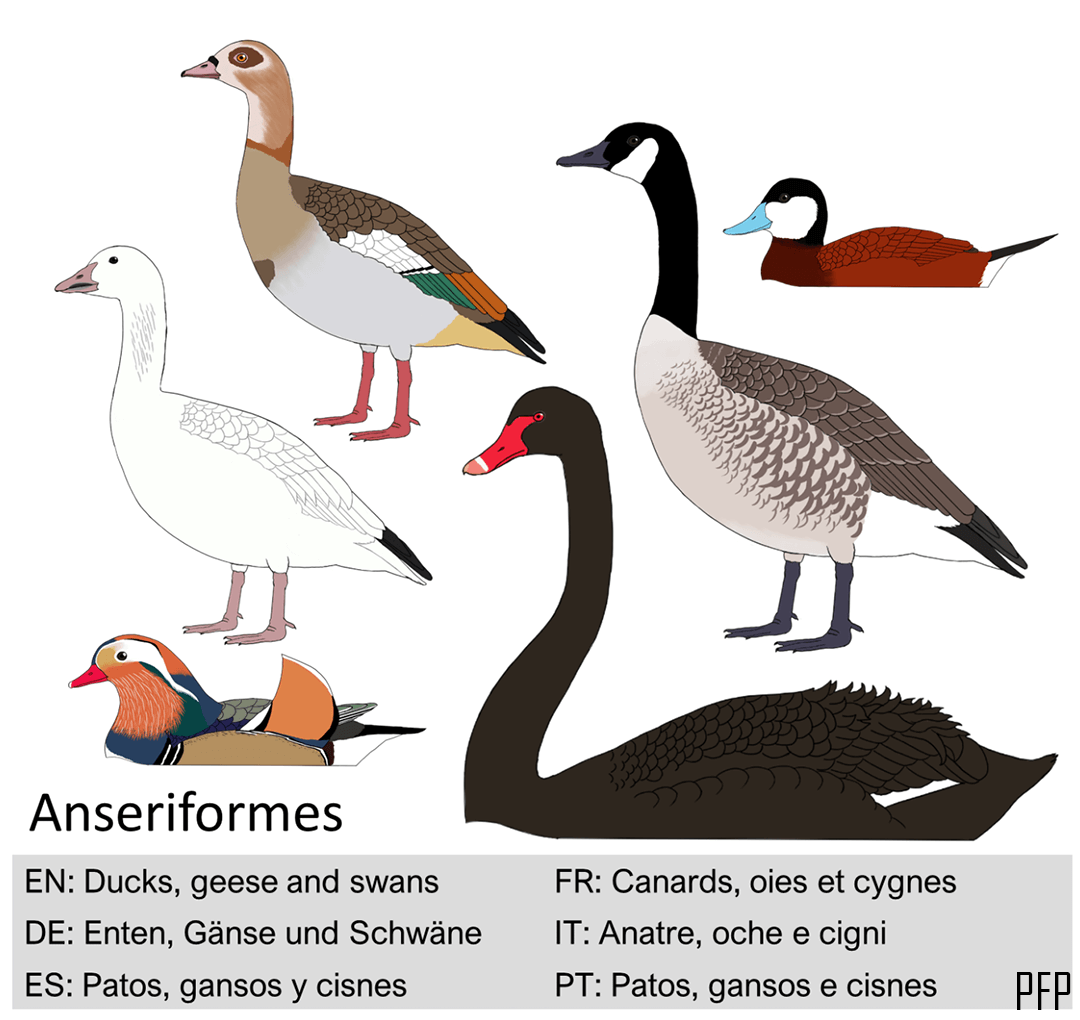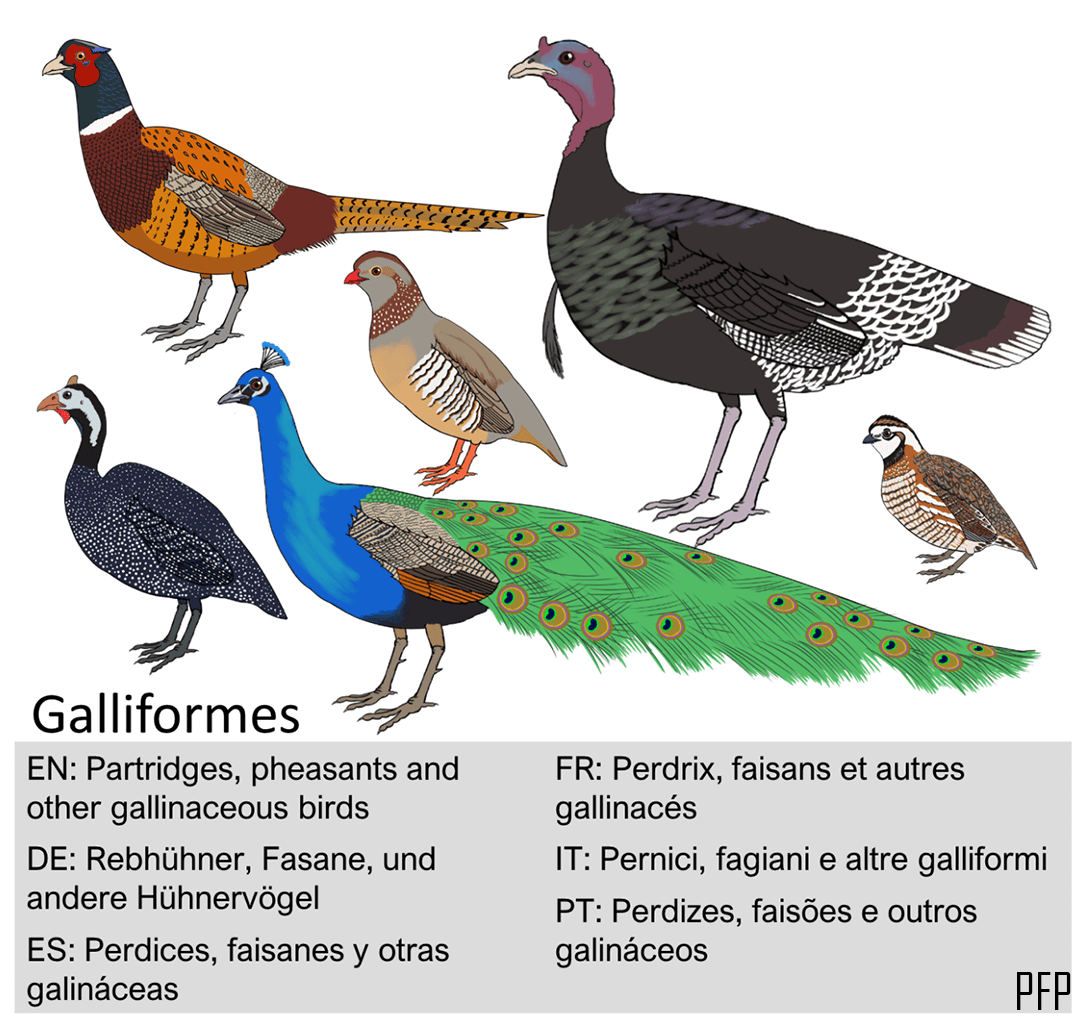RESULTADOS DE IBISURVEY
última actualización: 23/04/2024
Número de observaciones
Número de participantes
Número de especies de aves exóticas
Las 5 especies principales reportadas
- 387| Cotorra de Kramer (Psittacula krameri) 23%
- 195| Ganso del Nilo (Alopochen aegyptiaca) 12%
- 152| Leiótrix piquirrojo (Leiothrix lutea) 9%
- 151| Ibis sagrado (Threskiornis aethiopicus) 9%
- 105| Cotorra argentina (Myiopsitta monachus) 6%
Interacciones para todas las especies exóticas
Número de observaciones por país
- 504| PT 30%
- 419| IT 25%
- 217| ES 13%
- 179| FR 11%
- 128| DE 8%
- 53| UK 3%
- 45| NL 3%
- 21| CH 1%
- 20| BE 1%
- 17| PL 1%
- 13| GR 1%
- 10 | RS 1%
- 5 | HR 0%
- 5| TR 0%
- 4 | AL 0%
- 3 | SE 0%
- 3 | SK 0%
- 2| AZ 0%
- 2 | BG 0%
- 2 | DK 0%
- 2| LU 0%
- 2 | NO 0%
- 1| AT 0%
- 1 | CY 0%
- 1| CZ 0%
- 1 | FI 0%
- 1| HU 0%
- 1 | IE 0%
- 1 | RO 0%
- 1 | RU 0%
¿Ha visto un ave introducida en estado silvestre?
¿Qué tipo de comportamientos observó?
Las aves mostraron comportamiento reproductivo

Las aves mostraron otros comportamientos

¡Envíe su registro de observación!
¡Envíe su registro de observación!
› con fotos: usuarios de Gmail | otras cuentas
› sin fotos
¡Gracias por su participación!
El Proyecto
Introducción
Desde la antigüedad, varias especies de animales y plantas fueron transportadas fuera de su distribución natural para la producción de recursos (por ejemplo alimentos, madera), con fines de caza o como especies ornamentales. Parte de ese transporte resulta en introducciones intencionales o accidentales en la naturaleza. El hecho de que la especie no sea originaria de un país o región la hace exótica o alóctona en ese nuevo lugar. Una pequeña proporción de esas especies exóticas introducidas encuentra las condiciones adecuadas para asentarse y reproducirse en el nuevo lugar e iniciar un proceso de establecimiento sin apoyo humano. Una proporción aún menor de esas especies establecidas pueden volverse invasoras si aumentan en número y se dispersan más allá del lugar de introducción, lo que puede causar impactos negativos en el medio ambiente, la agricultura, la salud humana o la economía.
Desafíos
El impacto de las especies introducidas es difícil de evaluar cuando no se obtienen sistemáticamente datos sobre su distribución, abundancia y comportamiento.
Las especies introducidas pueden ser desconocidas para la mayoría de los ciudadanos porque a menudo se pasan por alto en las guías de aves populares, se restringen a una región en particular o se pueden confundir con algunas especies nativas.
Objetivos
La “Encuesta de interacciones con aves introducidas” (Introduced Bird Interaction Survey – IBISurvey en inglés) es un proyecto de ciencia ciudadana de la Universidad de Évora (Portugal) con el objetivo principal de evaluar los impactos ambientales, sociales y económicos de las aves introducidas en los países europeos. Reportar el comportamiento de las aves introducidas es la clave para determinar sus impactos, concretamente daños en cultivos o su agresividad hacia individuos de especies nativas. Específicamente, el proyecto tiene como objetivos (1) facilitar la identificación de aves introducidas al público en general, (2) obtener información sobre la distribución, abundancia y comportamiento de las especies introducidas, y (3) aumentar la conciencia pública sobre el impacto de especies introducidas.
La encuesta
Con la «Encuesta de interacciones con aves introducidas«, animamos a los ciudadanos a reportar interacciones entre las aves introducidas y otros animales, plantas y seres humanos. Los observadores pueden reportar cualquier especie de ave exótica introducida y detectada en condiciones silvestres en Europa escribiendo el nombre de la especie o seleccionando una especie de una lista de las observadas más frecuentemente. Además, los registros de especies europeas que fueron introducidas en países donde no se encuentran naturalmente también son elegibles y bienvenidos.
Su colaboración es esencial para que podamos identificar qué especies de aves introducidas se están volviendo invasoras y para mejorar nuestra evaluación de sus impactos ambientales, sociales y económicos. Por ejemplo, los hábitos alimenticios de un ave pueden revelar un impacto negativo en áreas agrícolas o una ventaja competitiva sobre una especie nativa. Reportar el comportamiento reproductivo de los individuos también es importante para determinar la colonización o el éxito de establecimiento de una especie. Además, describir la época del año, el hábitat de ocurrencia o el área de reproducción aumentará el conocimiento de la ecología de las especies en la nueva región y es esencial para mejorar la investigación o para establecer programas de erradicación exitosos.
Especies objetivo: aves introducidas (o sus descendientes) observadas en condiciones de libertad en un lugar al que llegaron por la mano humana.
Especies no objetivo: aves observadas en cautividad, como jaulas en parques zoológicos (aves voladoras) o cercados (aves no voladoras).
IBISurvey es un socio de la Red Europea de Información sobre Especies Exóticas (EASIN).
Fichas de especies
Hemos elaborado fichas informativas para las especies de aves exóticas (1) introducidas con éxito (establecidas) en Europa o (2) para las observadas con frecuencia en la naturaleza pero sin poblaciones establecidas conocidas. Una ficha de especie resume (1) consejos de identificación basados en el plumaje de las aves y una comparación con especies similares, (2) la ecología de la especie y (3) el estado actual de establecimiento de la especie en cada región y país europeo.
En cuanto a los plumajes, se muestran tres tipos: (1) tipo silvestre: plumaje presente de forma natural en los individuos de su país de origen; (2) tipo doméstico: plumaje resultante de la selección humana y la cría doméstica; (3) híbrido: plumaje resultante del cruce entre diferentes especies. Para los tipos domésticos e híbridos solo se muestran los ejemplos más comunes.
El estado de la especie en Europa es una sección que se actualiza continuamente porque las aves siguen escapándose o siendo introducidas o porque el proceso de establecimiento lleva tiempo. Además, posiblemente haya poblaciones introducidas todavía esperando ser descubiertas.
Para saber cómo identificar una especie de ave introducida en Europa, haga clic aquí:
Patos, gansos y cisnes (Anseriformes)
Perdices, faisanes y otras galináceas (Galliformes)
Loros y cotorras (Psittaciformes)
Bibliografía y enlaces útiles
Taxonomia y nomenclatura:
Gill F, D Donsker & P Rasmussen (Eds). 2021. IOC World Bird List (v11.2). doi: 10.14344/IOC.ML.11.2.
Lepage, D., Vaidya, G., & Guralnick, R. (2014). Avibase – a database system for managing and organizing taxonomic concepts. ZooKeys, (420), 117.
Rouco, M., Copete, J. L., De Juana, E., Gil-Velasco, M., Lorenzo, J. A., Martín, M., Milá, B., Molina, B. & Santos, D. M. 2019. Lista de las aves de España. Edición de 2019. SEO/BirdLife. Madrid.
Enlaces útiles para figuras, videos y cantos de aves: http://www.ebird.org y www.xenocanto.org
Ali, S., & Ripley, S. D. (1999). Handbook of the Birds of India and Pakistan: Together with those of Bangladesh, Nepal, Sikkim, Bhutan and Sri Lanka. 10 Volume Set (Vol 1-10). Oxford University Press.
Andreotti, A., Besa, M., Genovesi, P., & Guberti, V. (2001). Mammiferi e Uccelli esotici in Italia: analisi del fenomeno, impatto sulla biodiversità e linee guida gestionali. N. Baccetti, & A. Perfetti (Eds.). Ministero dell’ambiente, Servizio conservazione natura.
Anton, M., Herrando, S., Garcia, D., Ferrer, X. & Cebrian, R. (2017). Atles dels ocells nidificants de Barcelona. Ajuntament de Barcelona/ICO/UB/Zoo. Barcelona
Arnold, R., Woodward, I. and Smith, N. (2018). Parrots in the London Area – A London Bird Atlas Supplement. London Natural History Society
Baccetti, N., Spagnesi, M., & Zenatello, M. (1997). Storia Recente Delle Specie Ornitiche Introdotte In Italia. Suppl. Ric. Biol. Selvaggina 27: 299-316.
Baicich, P. J., & Harrison, C. J. 0. (2005). A guide to the nests, eggs, and nestlings of North American birds. Second Ediction. Princeton University Press, Princeton and Oxford.
Baker, J., Harvey, K. J., & French, K. (2014). Threats from introduced birds to native birds. Emu-Austral Ornithology, 114(1), 1-12.
Banks, A. N., Wright, L., Maclean, I. M., Hann, C., & Rehfisch, M. M. (2008). Review of the status of introduced non-native waterbird species in the area of the African-Eurasian Waterbird Agreement: 2007 update. Norfolk, United Kingdom: British Trust for Ornithology.
Bauer, H. G., & Woog, F. (2008). Nichtheimische Vogelarten (Neozoen) in Deutschland, Teil I: Auftreten, Bestände und Status. Vogelwarte, 46(3), 157-194.
Bauer, H. G., Geiter, O., Homma, S., & Woog, F. (2016). Vogelneozoen in Deutschland–Revision der nationalen Statuseinstufungen. Vogelwarte, 54, 165-179.
Blackburn, T. M., & Duncan, R. P. (2001). Determinants of establishment success in introduced birds. Nature, 414(6860), 195-197.
Blackburn, T. M., Lockwood, J. L., & Cassey, P. (2009). Avian invasions: the ecology and evolution of exotic birds (Vol. 1). Oxford University Press.
Blackburn, T. M., Pyšek, P., Bacher, S., Carlton, J. T., Duncan, R. P., Jarošík, V., … & Richardson, D. M. (2011). A proposed unified framework for biological invasions. Trends in ecology & evolution, 26(7), 333-339.
Bon, M., Semenzato, M., Fracasso, G., & Marconato, E. (2008). Sintesi delle conoscenze sui Vertebrati alloctoni del Veneto. Boll. Mus. civ. St. nat. Venezia, 58, 37-64.
Borrow, N., & Demey, R. (2014). Birds of Western Africa. Helm Field Guides, London.
Carrete, M., & Tella, J. (2008). Wild‐bird trade and exotic invasions: a new link of conservation concern?. Frontiers in Ecology and the Environment, 6(4), 207-211.
Cassey, P., Blackburn, T. M., Sol, D., Duncan, R. P., & Lockwood, J. L. (2004). Global patterns of introduction effort and establishment success in birds. Proceedings of the Royal Society of London. Series B: Biological Sciences, 271(suppl_6), S405-S408.
Cheke, A. (2019). A long-standing feral Indian Peafowl population in Oxfordshire, and a brief survey of the species in Britain. British Birds, 112, 337-348.
Chiron, F., Shirley, S., & Kark, S. (2009). Human-related processes drive the richness of exotic birds in Europe. Proceedings of the Royal Society B: Biological Sciences, 276(1654), 47-53.
Clement, P. (1999). Finches and sparrows. Bloomsbury Publishing.
Cramp, S. & Perrins, C. M. (1994). The birds of the Western Palearctic. Oxford University Press, Oxford
Cucco, M., Alessandria, G., Bissacco, M., Carpegna, F., Fasola, M., Gagliardi, A., … & Pellegrino, I. (2021). The spreading of the invasive sacred ibis in Italy. Scientific Reports, 11(1), 1-13.
De Juana, E., & Garcia, E. (2015). The birds of the Iberian Peninsula. Bloomsbury Publishing.
Del Hoyo, J., Elliott, A., Sargatal, J., Christie, D. A., & de Juana, E. E. (2018). Handbook of the birds of the world alive. Barcelona: Lynx Edicions.
Dubois, P. J. (2007). Les oiseaux allochtones en France: statut et interactions avec les espèces indigènes. Ornithos, 14, 329–364.
Dubois, P. J., Maillard, J. F., & Cugnasse, J. M. (2016). Les populations d’oiseaux allochtones en France en 2015 (4 e enquête nationale). Ornithos, 23, 129-141.
Duncan, R. P., Blackburn, T. M., & Sol, D. (2003). The ecology of bird introductions. Annual Review of Ecology, Evolution, and Systematics, 34(1), 71-98.
Dunn, J. L. & Alderfer, J. (2017). Field guide to the birds of North America. National Geographic Books.
Essl, F. & Rabitsch, W. (2002): Neobiota in Österreich. Umweltbundesamt, Wien, 432 pp.
Fox, A. D., Heldbjerg, H., & Nyegaard, T. (2017). Invasive alien birds in Denmark. Citizen Science Based Bird Population Studies, 187.
Frith, C. B. (2004). The Birds of Africa. Volume VII (Eds C. Hilary Fry and Stuart Keith). Christopher Helm, London.
Gibbs, D., Barnes, E., & Cox, J. (2010). Pigeons and doves: a guide to the Pigeons and doves of the world. London, UK: A&C Black Publishers
Global Biodiversity Information Facility: http://www.gbif.org
Hagemeijer, W. J., & Blair, M. J. (1997). The EBCC atlas of European breeding birds. Poyser, London, 479.
Harrison, C. J. O. & Castel, P. (2002). Field guide to the nests, eggs and nestlings of Britain and Europe. Collins.
Holling, M., & the Rare Breeding Birds Panel. (2017). Non-native breeding birds in the UK, 2012–14. Brit. Birds 110: 92–108
Hulme, P. E., Bacher, S., Kenis, M., Klotz, S., Kühn, I., Minchin, D., … & Vilà, M. (2008). Grasping at the routes of biological invasions: a framework for integrating pathways into policy. Journal of Applied Ecology, 45(2), 403-414.
iNaturalist: www.inaturalist.org
Institute of Nature Conservation PAS: http://www.iop.krakow.pl
Invasive Species in Belgium: http://ias.biodiversity.be/
Johnsgard, P. A. (1978). Ducks, geese, and swans of the world. – University of Nebraska Press, 1st edition, Lincoln, Nebraska
Keller, V., Herrando, S., Voříšek, P., Franch, M., Kipson, M., Milanesi, P., Martí, D., Anton, M., Klvaňová, A., Kalyakin, M.V., Bauer, H.-G. & Foppen, R.P.B. (2020): European Breeding Bird Atlas 2: Distribution, Abundance and Change. European Bird Census Council & Lynx Edictions. Barcelona
Kestenholz, M., Heer, L., & Keller, V. (2005). Etablierte Neozoen in der europäischen Vogelwelt–eine Übersicht. Ornithol. Beob, 102(3), 153-180.
Kumschick, S., & Nentwig, W. (2010). Some alien birds have as severe an impact as the most effectual alien mammals in Europe. Biological conservation, 143(11), 2757-2762.
Lensink, R., Ottens, G., & van der Have, T. (2013). Vreemde vogels in de Nederlandse vogelbevolking: een verhaal van vestiging en uitbreiding. Limosa, 86(2), 49-67.
Lever, C. (2005). Naturalised birds of the world. A&C Black.
Lukasiewicz, M., Matuszewski, A., Kamaszewski, M., & Wardecki, L. (2018). Selected invasive species of the Polish and European avifaunae. Annals of Warsaw University of Life Sciences-SGGW. Animal Science, 57.
Madge, S., McGowan, P. J., & Kirwan, G. M. (2002). Pheasants, partridges and grouse: a guide to the pheasants, partridges, quails, grouse, guineafowl, buttonquails and sandgrouse of the world. A&C Black
Matias, R. (2002). Aves exóticas que nidificam em Portugal continental. Instituto da Conservação da Natureza. Lisboa
Menkhorst, P., Rogers, D., Clarke, R., Davies, J., Marsack, P., & Franklin, K. (2017). The Australian bird guide. Csiro Publishing.
Mentil L., Battisti C. & Carpaneto G.M. (2018). The impact of Psittacula krameri (Scopoli, 1769) on orchards: first quantitative evidence for Southern Europe. Belgian Journal of Zoology 148 (2): 129–134.
Mlíkovský, J. & Stýblo P. (Eds.) (2006): Nepůvodní druhy fauny a flóry České republiky. Praha: ČSOP.
Mori, E., Grandi, G., Menchetti, M.,Tella, J. L., Jackson, H. A., Reino, L., van Kleunen, A., Figueira, R. & Ancillotto, L. (2017). Worldwide distribution of non–native Amazon parrots and temporal trends of their global trade. Animal Biodiversity and Conservation, 40.1: 49–62.
National Biodiversity Network Atlas: https://records.nbnatlas.org
Naturbasen – Danmarks National Artsportal: https://www.naturbasen.dk/
Nehring, S., Rabitsch, W., Kowarik, I., & Essl, F. (Eds.). (2015). Naturschutzfachliche Invasivitätsbewertungen für in Deutschland wild lebende gebietsfremde Wirbeltiere. Bundesamt für Naturschutz.
Nikolov, B., Kralj, J., Legakis, A., Saveljic, D. & Velevski, M. (2016). Review of the alien bird species recorded on the Balkan Peninsula. In: Rat M., T. Trichkova, R. Scalera, R. Tomov, A. Uludag (Eds.), First ESENIAS Report: State of the Art of Invasive Alien Species in South-Eastern Europe. Publishers: UNS PMF, Novi Sad, Serbia, IBER-BAS, Sofia, Bulgaria, ESENIAS, ISBN:978-86-7031-3316, 189-201
Norwegian Biodiversity Information Centre (2018). The Alien Species List of Norway – ecological risk assessment 2018. https://www.biodiversity.no/alien-species-2018
Nowakowski, J. J., & Dulisz, B. (2019). The Red-vented Bulbul Pycnonotus cafer (Linnaeus, 1766)–a new invasive bird species breeding in Europe. BioInvasions Records, 8(4), 947-952.
Ornitho France: http://www.Ornitho.fr
Ornitho Italia: http://www.ornitho.it
Ottens, G., & Ryall, C. (2003). House crows in the Netherlands and Europe. Dutch Birding, 25, 312-319.
Pagani–Núñez, E., Renom, M., Furquet, C., Rodríguez, J., Llimona, F., & Senar, J. C. (2018). Isotopic niche overlap between the invasive leiothrix and potential native competitors. Animal Biodiversity and Conservation, 41(2), 427-434.
Parr, M., & Juniper, T. (2010). Parrots: a guide to parrots of the world. Bloomsbury Publishing.
Pereira, P. F., Barbosa, A. M., Godinho, C., Salgueiro, P. A., Silva, R. R., & Lourenço, R. (2020). The spread of the red-billed leiothrix (Leiothrix lutea) in Europe: The conquest by an overlooked invader?. Biological Invasions, 22(2), 709-722.
Pereira, P. F., Godinho, C., Vila-Viçosa, M. J., Mota, P. G., & Lourenço, R. (2017). Competitive advantages of the red-billed leiothrix (Leiothrix lutea) invading a passerine community in Europe. Biological Invasions, 19(5), 1421-1430.
Pereira, P. F., Lourenço, R., & Mota, P. G. (2018). Behavioural dominance of the invasive red-billed leiothrix (Leiothrix lutea) over European native passerine-birds in a feeding context. Behaviour, 155(1), 55-67.
Pereira, P. F., Lourenço, R., & Mota, P. G. (2020). Two songbird species show subordinate responses to simulated territorial intrusions of an exotic competitor. acta ethologica, 23(3), 143-154.
Poole, K. (2010). Bird introductions. Extinctions and Invasions: a social history of British fauna, 155-165.
Ramellini, S., Simoncini, A., Ficetola, G. F., & Falaschi, M. (2019). Modelling the potential spread of the Red-billed Leiothrix Leiothrix lutea in Italy. Bird Study, 66(4), 550-560.
Rasmussen, P. C., & Anderton, J. C. (2012). Birds of south Asia. The Ripley Guide. Vols. 1 and 2. Second Edition. National Museum of Natural History – Smithsonian institution, Michigan State University and Lynx Edictions, Washington, D.C., Michigan and Barcelona.
Robson, C. (2008). A field guide to the birds of South-east Asia. London, UK: New Holland Publishers Ltd.
Sanz-Aguilar, A., Anadón, J.D., Edelaar, P., Carrete, M. & Tella, J.L. (2014). Can Establishment Success Be Determined through Demographic Parameters? A Case Study on Five Introduced Bird Species. PLoS ONE 9(10): e110019. doi:10.1371/journal.pone.0110019
Senar, J. C., Carrillo-Ortiz, J. G., Ortega-Segalerva, A., Dawson Pell, F. S. E., Pascual, J., Arroyo, L., … & Hatchwell, B. J. (2019). The reproductive capacity of Monk Parakeets Myiopsitta monachus is higher in their invasive range. Bird Study, 66(1), 136-140.
Sibley, D.A. (2014). The North American Bird Guide. 2nd Edition. Bloomsbury, New York.
Sol, D., Bartomeus, I., & Griffin, A. S. (2012). The paradox of invasion in birds: competitive superiority or ecological opportunism?. Oecologia, 169(2), 553-564.
Sol, D., Timmermans, S., & Lefebvre, L. (2002). Behavioural flexibility and invasion success in birds. Animal behaviour, 63(3), 495-502.
Species Obseration System – SLU Artdatabanken: https://www.artportalen.se/
Šťastný, K. (2018). Nepůvodní ptáci ve fauně České republiky. Živa 5/2018: 272-276.
Svensson, L., Mullarney, K., & Zetterström, D. (2010). Collins bird guide 2nd edition. British Birds, 103, 248-252.
UNEP-WCMC. 2015. Update on the status of non-native waterbird species within the AEWA Area. Cambridge: UNEP-WCMC
Vall-llosera, M., Llimona, F., de Cáceres, M., Sales, S., & Sol, D. (2016). Competition, niche opportunities and the successful invasion of natural habitats. Biological invasions, 18(12), 3535-3546.
Vavřík M., Šírek J., Šindel M., Mlíkovský J., Horáček J., Heyrovský D. & Šimek J. 2019: Revize záznamů vzácných druhů ptáků v České republice. Sylvia 55: 2–74.
Waarneming: https://waarneming.nl
Waarnemingen: https://waarnemingen.be
White, R. L., Strubbe, D., Dallimer, M., Davies, Z. G., Davis, A. J., Edelaar, P., … & Shwartz, A. (2019). Assessing the ecological and societal impacts of alien parrots in Europe using a transparent and inclusive evidence-mapping scheme. NeoBiota, 48, 45.
Yésou, P. & Clergeau, P. (2005). Sacred Ibis: a new invasive species in Europe. Birding World 18 (12): 517-526.
Colaboradores y financiación
Grupo de investigación (University of Évora, Portugal):
Pedro Filipe Pereira
Carlos Godinho
Inês Roque
João Eduardo Rabaça
Rui Lourenço
Colaboradores:
Ana Diniz Sampaio, University of Évora
David Epple, Technical University of Munich
Elsa Leclerc Duarte, University of Évora
Fer Goytre, Fotografía de Naturaleza
Francesco Valerio, University of Évora
Hany Alonso, Portuguese Society for the Study of Birds (SPEA)
Pedro Alexandre Salgueiro, University of Évora
Pedro Almeida, University of Évora
Teresa Gomes, University of Évora
Ilustraciones:
Pedro Filipe Pereira
Fotografias:
Alessandro Mariani, Italia; Leiothrix lutea y Parus major
Carlos Santos, Alapraia, Portugal; Acridotheres cristatellus cantando
Carlos Sarabia, Fotografía de Naturaleza, España; Pycnonotus jocosus
Carole Philippon, France, Instagram: @carole.nature.photos; Encuesta: Leiothrix lutea y Erithacus rubecula
Christian Almendro, España, Instagram: @kostripadventure; Pavo cristatus cortejo
Elena Giuffra, Italia, Instagram: @elena.giuffra; 2 Leiothrix lutea alimentación
Eva M Sánchez-Flores, España, Instagram: @evalynxphotograph; Estrilda astrild alimentación
Fátima Mendes, Portugal; Acridotheres cristatellus y caballo
Francisco Santos, Portugal; Estrilda astrild alimentando crías
Hawi Grömping, Germany, www.naturschule.com; Encuesta: Phoenicopterus chilensis y Phoenicopterus roseus
Jean Yves Paquereau, photographie de la nature, France; Threskiornis aethiopicus
João Lelo, Portugal, Instagram: @joaolelophotography; Ploceus melanocephalus
Mala Patel, Director The Caketail Club, England, the United Kingdom; 2 Psittacula krameri
Mar López, Fotografía de Naturaleza, Alcalá de Henares, España; Myiopsitta monachus alimentación
Mari Carmen López Luengo, España, Instagram: @mcarmen_photography; Myiopsitta monachus y Columba livia
Paul Abrahams, the United Kingdom, www.gingerwildlifephotography.co.uk; Branta canadensis y Anser anser; Branta canadensis y Cygnus olor
Pedro Filipe Pereira, University of Évora, Portugal; Pavo cristatus incubando
Peter Koenis, the Netherlands; Cygnus atratus y Cygnus olor
Philip John Passey, England, the United Kingdom; Psittacula krameri y Corvus monedula
Samuele Ramellini, University of Milan, Italy; Leiothrix lutea pareja; 1 Leiothrix lutea alimentación
Saskia Lemmens, Sayly Photography, the Netherlands; Alopochen aegyptiaca y Ciconia ciconia
Teresa Palacios, Fotógrafa, España, www.teresapalacios.es; Phasianus colchicus cortejo
Ton Petrus, the Netherlands; Psittacula krameri alimentación
Vie Schoen, the Netherlands; Phoenicopterus chilensis apareamiento
William Atkinson, Mid-Wales, the United Kingdom; Phasianus colchicus lucha
Financiación:
MED (IUPB/05183/2020) – Fundação para a Ciência e Tecnologia
Contactos:
LabOr – Laboratory of Ornithology
MED – Mediterranean Institute for Agriculture, Environment and Development
Instituto de Investigação e Formação Avançada
Universidade de Évora, Pólo da Mitra, Ap. 94, 7006-554 Évora, Portugal
Teléfono: 00351 266 760 897
E-mail: labor@uevora.pt
Descargas
- IBISurvey Proyecto en una página
- IBISurvey Booklet Brochure A5
- IBISurvey Poster Affiche 90 x 60 cm
- I Congreso Ibérico de Especies Invasoras (en inglés, páginas 123-128)
- Código de conducta Comercio electrónico de flora y fauna exótica invasora
- Código de conducta Zoológicos, acuarios y especies exóticas invasoras en la Península Ibérica
- Código de conducta Prevención de la introducción y dispersión de flora y fauna exótica invasora: agentes ambientales
Research Team (University of Évora, Portugal)

Carlos Godinho
Inês Roque
João Eduardo Rabaça
Pedro Filipe Pereira
Rui Lourenço
Las aves mostraron comportamiento reproductivo
Ganso del Nilo (Alopochen aegyptiaca) – competencia por los sitios de anidación / comportamiento agresivo: de la especie introducida hacia otro animal (Cigüeña blanca – Ciconia ciconia)
Faisán vulgar (Phasianus colchicus) – comportamiento territorial (lucha) / comportamiento agresivo: entre individuos de la especie introducida
Cotorra de Kramer (Psittacula krameri) – competencia por los sitios de anidación / comportamiento agresivo: de la especie introducida hacia otro animal (Grajilla occidental – Corvus monedula)
Las aves mostraron otros comportamientos
Leiótrix piquirrojo (Leiothrix lutea) – alimentación: cultivos (caqui)
Estrilda común (Estrilda astrild) – alimentación: plantas silvestres (semillas de junco)
Cotorra de Kramer (Psittacula krameri) – alimentación: comida del comedero de aves / comportamiento agresivo: entre individuos de la especie introducida
Leiótrix piquirrojo (Leiothrix lutea) – alimentación: cultivos (caqui) / comportamiento agresivo: de la especie introducida hacia otro animal (Carbonero Común – Parus major)
Cotorra de Kramer (Psittacula krameri) – alimentación: plantas ornamentales (flores de cerezo)
Barnacla canadiense grande (Branta canadensis) – nadando / comportamiento agresivo: de la especie introducida hacia otro animal (Ánsar común – Anser anser)
Barnacla canadiense grande (Branta canadensis) – nadando / comportamiento agresivo: de un animal (Cisne vulgar – Cygnus olor) hacia la especie introducida
Cisne negro (Cygnus atratus) – nadando / comportamiento agresivo: de la especie introducida hacia otro animal (Cisne vulgar – Cygnus olor)
Cotorra argentina (Myiopsitta monachus) – comportamiento social: la especie introducida estaba asociada con otro animal (Paloma doméstica – Columba livia) sin mostrar un comportamiento agresivo
Miná crestado (Acridotheres cristatellus) – comportamiento social: la especie introducida estaba asociada con otro animal (caballo) sin mostrar un comportamiento agresivo



